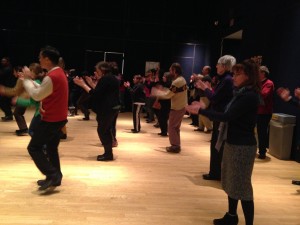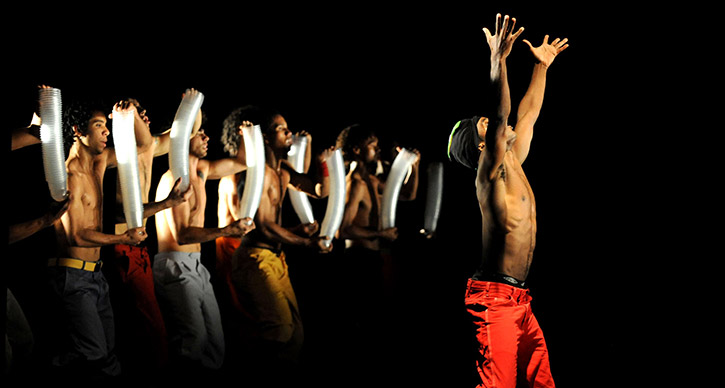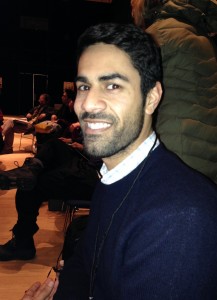UMS Night School: Bodies in Motion – Session 3 Recap
Editor’s note: This post is a part of a series of by U-M student Sarah Squillante, who’s covering our free UMS Night School: Bodies in Motion series. Learn along side with them.

UMS Night School attendees danced to a new beat this week – literally. Midway through the session, attendees were asked to get up on their feet, learn a basic Capoeira step, and then free-style in a large circle to funk music. The movement exercise, led by U-M Dance MFA Candidate Marcus Whiten, gave attendees a kinesthetic taste of a distinct style – a mix of hip hop, martial arts, and acrobatics – that Compagnie Käfig will bring to Ann Arbor this weekend, February 14 and 15.
This week also marked the beginning of a new format in which attendees have the opportunity to discuss a recent dance performance. This week’s discussion centered around “Moving Pictures,” a concert featuring 4 works performed by the U-M department of Dance. In a short panel discussion, three dancers spoke first of the larger ideas that they were asked to conceptualize during the beginning stages of the pieces, then progressed to more specific elements of the performance, like costuming and live music. The dancers expressed delight in the challenges that the pieces provided and in the connections that they were able to make with the audience.
The attendees comprised a diverse a group as usual, ranging from experienced dancers to those who had never seen a performance before. The class has grown significantly since the first week. Some have become Night School “regulars,” while others ventured out into the cold for the first time.
In the left photo, newcomer Razi Jafri said he came because he “didn’t really know anything about dance – artistically or technically,” so he figured it’d be a good introduction.
On the right, Lucie Cohen and Deb Taylor came to Night School thinking they’d be seeing a dance performance, but were pleasantly surprised by the discussion format. “I really enjoyed getting involved when we started moving. The proximity of our bodies made me feel like I knew people on a personal level,” Lucia said.
Leslie Woldenberg, a dance lover and frequent UMS patron, drove all the way from Toledo with a friend to experience Night School for the first time.
The session finished with a short talk from Reighan Gillam, Postdoctoral research fellow in the U-M Department of Afroamerican and African Studies, who spoke about the origins of hip-hop music and dance in Brazil. Gillam emphasized the fact that rappers come from the periphery of Brazil and that, much like hip hop in the United States, the content typically revolves around the violence and system inequality characteristic of marginalized groups.
The details – and the questions they inspired – were intended to help attendees frame their viewing of Compagnie Käfig. Night School host Clare Croft suggested that attendees use information from the lecture to consider how the atmosphere in Brazil may impact the movement they see on stage.
The fourth session of Night School will include an exploration of how actors think about movement, with a preparation for Théâtre des Bouffes du Nord’s The Suit, and also a discussion of Compagnie Käfig’s Correria Agwa. Special guests will include: Naomi Andre, U-M Associate Professor of Women’s Studies, Rob Najarian, U-M Assistant Professor of Theatre, and Michael Kondziolka, UMS Director of Programming. It will be held at the U-M Alumni Center at 200 Fletcher Street at 7 PM.
Session 3 Resources & Readings
- UMS Learning Guide on Compagnie Käfig
- Performance prep reading on Capoeira – “Headspin” by Barbara Browning
- Bodies in Motion Session 3 – Key Themes, Players, and Definitions [Word Document assembled by Marcus White, MFA Candidate – Dance, University of Michigan]
- Session 4 Prep Reading: Excerpt from Peter Brook’s The Open Door
Interested in even more dance engagement? Pick up an adventure card to learn all about the dance activities we’re offering this year and for a chance to win a backstage meet and greet.
For a complete list of 2013-2014 dance performances, visit ums.org. Share questions, comments, or suggestions in the comments below.
Interview: Kelvin Wyatt, Instructor at Tabcat Detroit

Photo: Compagnie Käfig, a dance company drawing on capoeira, performs in Ann Arbor on February 14-15, 2014. Photo by Michel Cavalka.
Recently, I had the chance to join in on a workshop with Tabcat Detroit, a Detroit-based dance group that teaches and performs a Brazilian folkloric dance called capoeira. We’re presenting Compagnie Käfig, a dance company that’s cross-polinating across genres and incorporating athletic samba, hip-hop, martial arts, capoeira dance, and even acrobatics into their style, on February 14-15, 2014, and we wanted to know more about the capoeira community locally.
As a ballerina, I was out of my element – banging on a drum and straining to mimic the Brazilian chanting – but in awe of what I could only describe as graceful athleticism. I had jumped at the opportunity to explore capoeira firsthand, but now, as the instructor was urging me to show off what I had learned during the hour in the center of the circle, I was feeling a bit apprehensive. My hips had grown sore from all the crouching, and I still wasn’t sure about the sequence of the steps. But as I floated around the room, squatting and kicking and singing, I experienced the elegance in this ancient dance form.
After class, I sat down with the group’s main instructor, Treinel Pequenininho (Kelvin Wyatt), to learn more about capoeira and his specific experiences with the art form.
Sarah Squillante (UMS): What is your background in capoeira?
Kelvin Wyatt: I’ve been training in capoeira for about 16 years. Seven years ago, I started training in traditional Capoeira Angola of Bahia. My interest began in high school, after I saw capoeira for the first time in a movie called Only the Strong. The next day at school, I met this new person named Tadarius in art class. And as I was riding my bike home, I watched somebody doing cartwheels and kicks in front of his house, and I flipped off my bike. When I got up and went over, it turned out to be Tadarius, the same person I had met in art class.
He told me he was training with a group on the west side of Detroit. So from there, I trained and trained. I really believe that the universe made it possible for me to meet Tadarius and give me a means for my journey in capoeira.
I met Mestre Caboclinho, a master in capoeira Angola of Brazil, in 1999 at a workshop that was given at the Serengeti Ballroom in downtown Detroit. In 2007, I came across him again. Mestre Caboclinho emphasized on the complete culture of capoeira, not just throwing kicks. He took me under his wing and helped make me the person I am today in capoeira. I’ve been teaching now since 2009.
SS: Where does capoeira come from? Can you tell me more about the art form?
KW: Capoeira itself is an art that was developed over 500 years ago by Africans in Brazil to celebrate life. The art is a mixture of African and Portuguese influences. Its purpose is to disguise self-defense into a dance and a game. Capoeira combines dance, music, song, acrobatics, and philosophy.
Acrobatics, in itself is a test of individuals, their capacity, what they can actually do inside of capoeira. Everybody has thought of that word, fear. But in capoeira, you don’t have fear anymore because it helps you let it go.
SS: Do you think capoeira is more of a dance or a martial art?
KW: For me, dance. I say dance because most of the time, especially for Americans, when people hear martial art, they always think fight fight fight, but the philosophy and everything inside of capoeira is that the strength is there, but you need to know your patience.
Even in the self-defense aspect, it’s all a game. If you have someone come to you and they’re using all their strength, it just knocks you off your feet. But if you move out of the way, it’s surprising. The attacker thinks, wait he’s escaping? He’s swaying out of the way? How did he do that? He did it again. Now I’ve let you fall into my game. Now I smile. In capoeira, we always smile. And then it’s like: Why is he smiling now? It’s capoeira.
SS: What makes capoeira challenging?
KW: I look at it as growth. It might be a challenge to people if they’ve never done an acrobatic move before, if they’ve never done a cartwheel or spoken a different language before. But with that in mind, if you have the capacity to learn, it’s not going to be a challenge.
SS: What makes it rewarding?
KW: What makes it rewarding is that we all have one goal. One goal may be to want to learn how to do a cartwheel, or to play all eight instruments. You set these goals, and these goals enrich life because capoeira teaches a lot about life. Some people come with really bad road rage. Capoeira helps them calm down. Some people just want a work out.Ccapoeira helps them work out. It touches everybody in a different way.
SS: Does Tabcat Detroit perform?
KW: Other than teaching regular capoeira classes, we do performances as well. This year, we performed for the Detroit Tigers, during Fiesta Tigre, at the main entrance to Comerica Park. There were thousands and thousands of people. What is this? They spin on their head, they do this, they jump in the air, they do no-handed cartwheels. capoeira – it’s here in Detroit. We’ve also performed for the College of Creative Studies, and at the University of Michigan, at an annual performance that we do for one of the professors. We’ve done a performance for the Kwanzaa celebration at the Charles H. Wright Museum in downtown Detroit as well.
SS: The movements are so graceful that they almost seem pre-choreographed.
KW: Capoeira is supposed to be natural. You have some people that practice capoeira as a choreographed art. They give each other signals. But traditional capoeira – the capoeira Angola that we teach – has more philosophy, more understanding.
SS: How has capoeira impacted the Detroit community?
KW: Everybody just looks at Detroit as far as the negative, not the positive. Granted, there are a lot of neighborhoods going down and things like that, but there are actual people in the city that do care. The work that I (and the people before me) have done for 14 years is to bring capoeira here so everybody could be happy.
I have seen it make the angriest person smile. I have seen it make someone cry. I have seen people take what they thought they couldn’t do and change it into something they could do. This has helped people learn that the tools are actually there.
I’ve seen it bring communities together. We’ve done performances where we play the berimbau [bow-like instrument] and batucada [a percussive, African-influenced Brazilian style of samba] through actual neighborhoods. People come out and they’re like: What’s that?
SS: How has capoeira impacted your life personally?
KW: Capoeira has helped me look at a lot of things that I thought were impossible and I find out that they are possible. It made me step out of my shell. It helped me realize I have something inside of me that I can share with everybody else. Something that can actually help people.
SS: Is there anything else you want to share with me about capoeira or your experiences?
KW: Well there’s one main aspect that my teacher always touched on: capoeira can – like I said – make the angriest person nice. Most people feel that when you do a kick, the kick is how you show strength. But in capoeira it’s in reverse. Who can make a beautiful game? Who can actually give a question and an answer? Are you going to respond strong, and get the person to fall? Or are you going to bring harmony to the game? That’s true capoeira – harmony. The self-defense is there. You know when to open your toolbox and use it. But other than that, it’s just enjoying it. Do something that’s healthy for you, not just for your body but your spirit.
To learn more about Tabcat Detroit, visit http://detroitcapoeira.com/.
On Feb. 14 and 15 at the Power Center, UMS will welcome Compagnie Käfig, a French-based group that draws heavily upon capoeira. For more information and tickets, visit ums.org.




